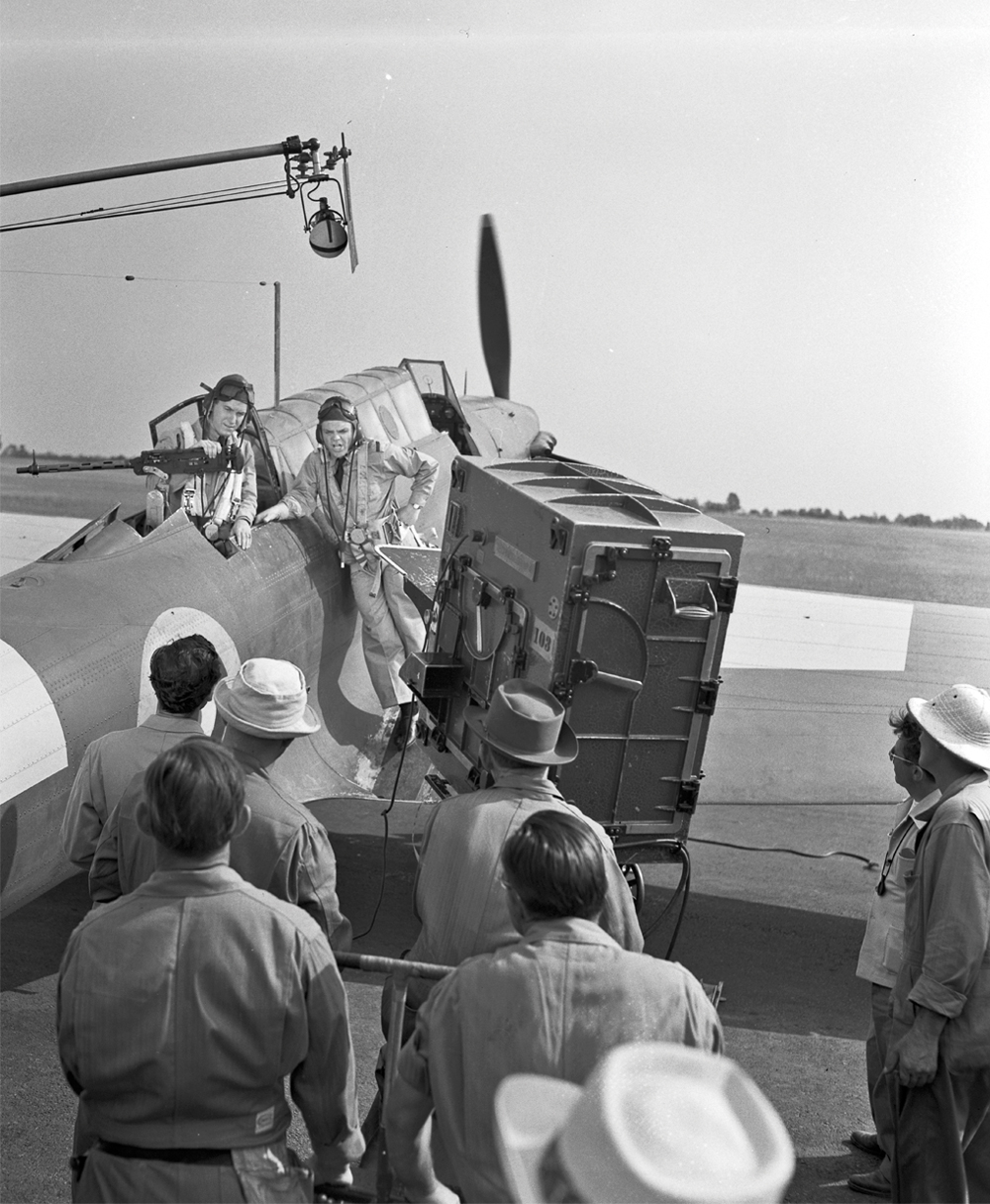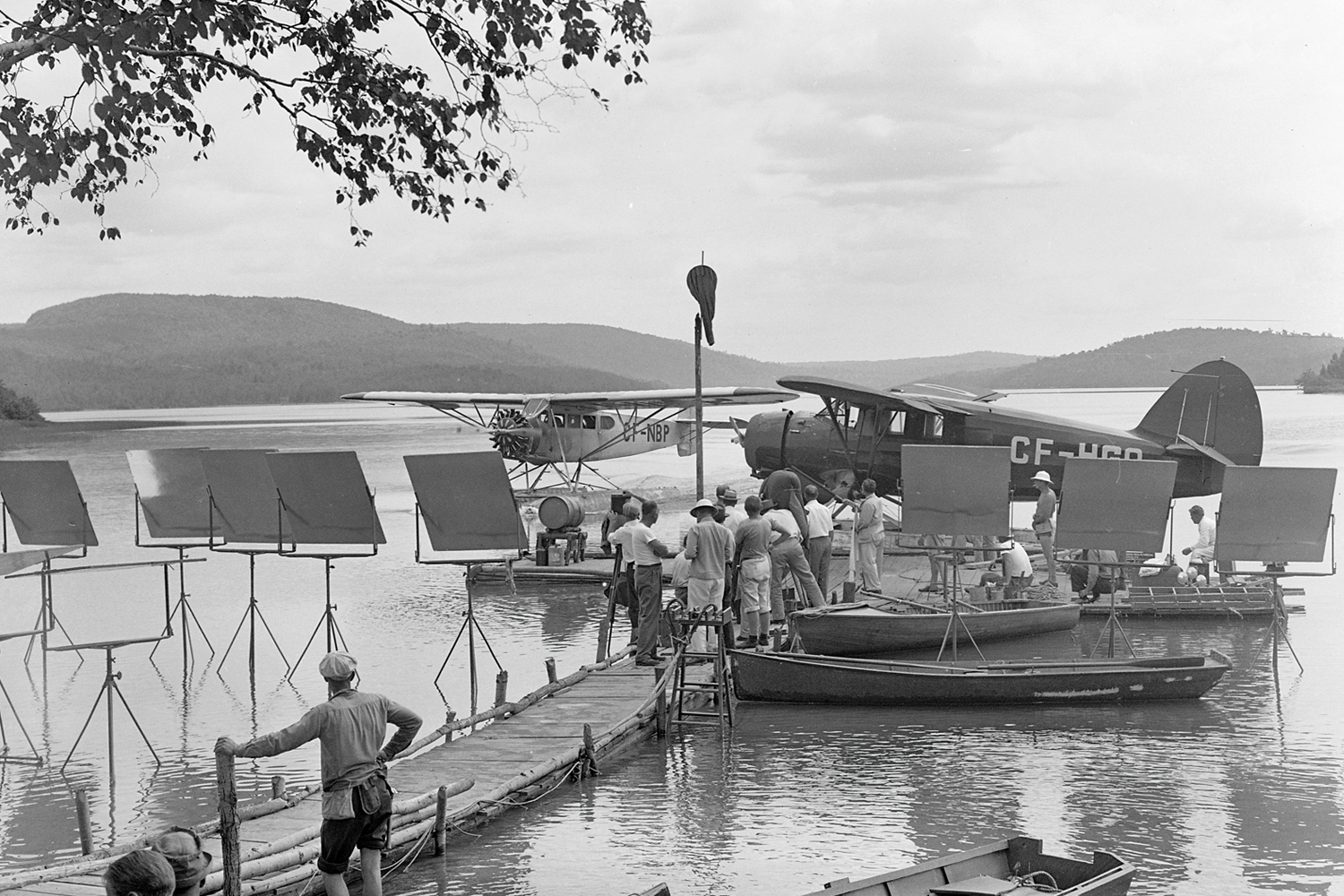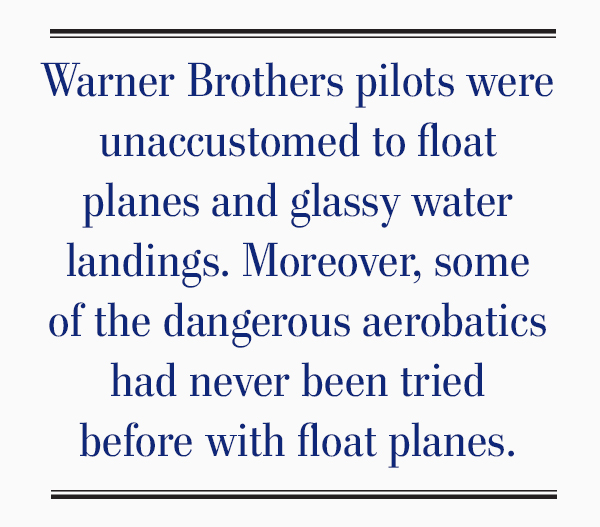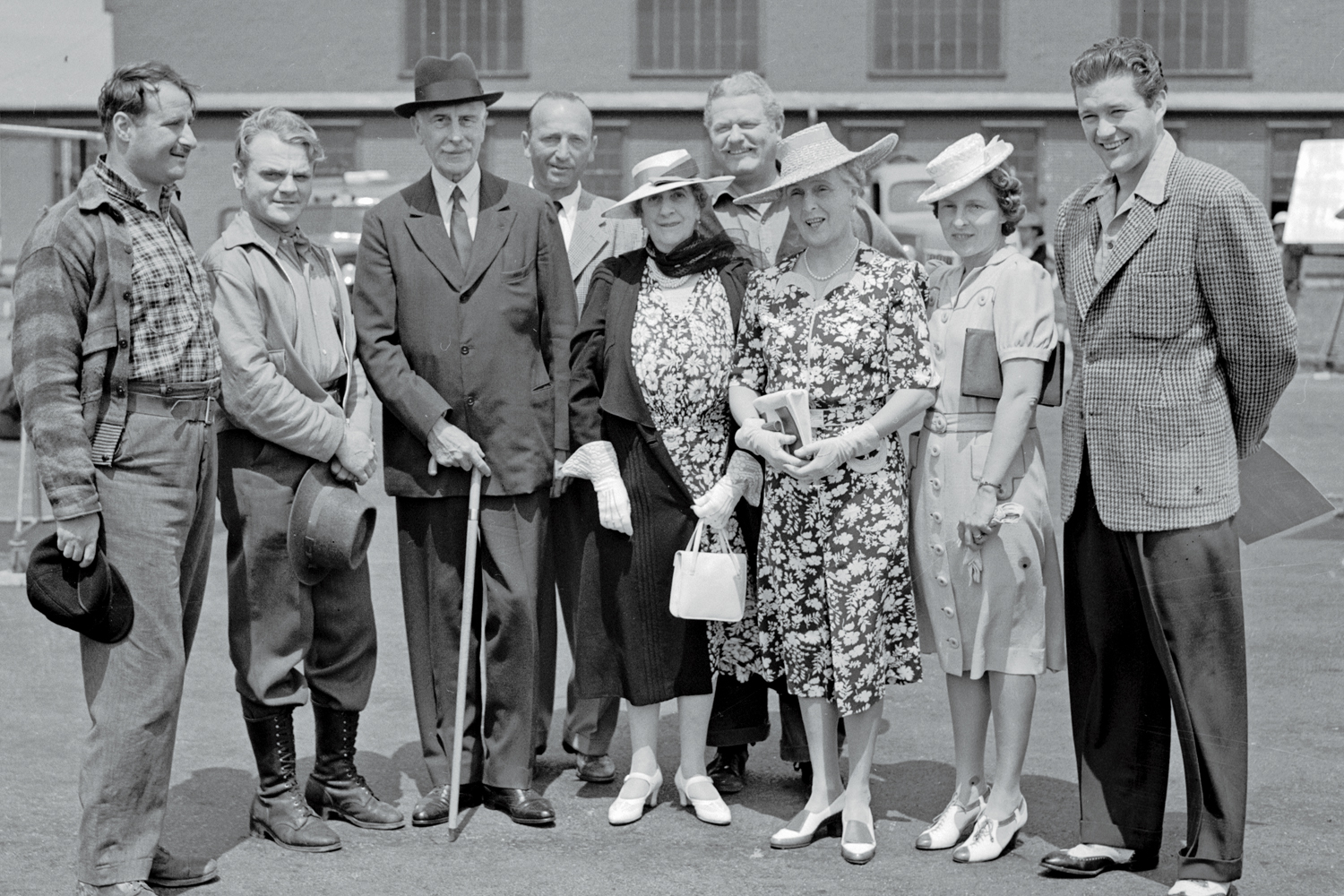

The film Captains of the Clouds often runs on TV movie channels. It is a favourite of those who like aviation movies. Where else can you find Billy Bishop playing himself?
In 1940-41, the United States was neutral, but Hollywood was anti-Nazi and pro-British. Britain, with Canada, established cordial relations with the American film industry. The making of Captains of the Clouds represented a symbolic melding of motion picture commercialism with Canadian nationalism and the war effort.
In fact, the idea originated with air force officials in Canada. They wanted to see production of a feature film that would publicize the Canadian war effort and especially the British Commonwealth Air Training Plan (BCATP).
The initial deal was signed on Jan. 28, 1941, by Joseph William Clark, DFC, the chief of a new RCAF public relations directorate, and executive producer Hal Wallis representing Warner Brothers. It was done at the Waldorf Astoria Hotel in New York, where a semi-secret organization, the Clayton Knight Committee, was recruiting Americans for the RCAF, in violation of U.S. neutrality laws. Norman Reilly Raine, who had written the Tugboat Annie stories as well as the script for such epics as The Adventures of Robin Hood, was tasked to write the new script. What resulted did not impress everyone. Air Commodore Robert Leckie, who was responsible for training, described it as “tripe,” but he still approved it.
Warner Brothers received enthusiastic assistance from the RCAF in preparation for shooting sites, training procedures and equipment. In April 1941, the force sent Flight Lieutenant Owen Cathcart-Jones to California as a special advisor to Warner Brothers. In June, he was promoted squadron leader, giving him more credibility with American authorities. He had already designed a board game, Be an Airman, based on stages of training in the BCATP. Eventually he played a cameo role in the film. Frequent meetings hammered out details of authenticity and the title itself—at least eight were proposed. Wallis himself suggested Captains of the Clouds, a phrase recently used by Bishop in a speech that had been printed in a motion picture trade paper. It was time to tell the world what was happening.

On July 1, Hollywood director Michael Curtiz announced that he was bringing to Ottawa some 50 Warner Brothers staff, from cameramen to stars, to shoot major segments of the upcoming flying epic. The first reports were buried inside the papers, but they gained greater prominence as the project developed.
The movie’s plot revolved around five pre-war bush pilots who join the RCAF in 1940. Two, played by James Cagney and Alan Hale, wash out. In frustration, they buzz a pilots’ graduation parade just as Air Marshal William “Billy” Bishop is presenting wings.

Curtiz and Warner Brothers chose to do much of the filming at No. 2 Service Flight Training School (SFTS), Uplands, just south of Ottawa. No. 2 SFTS was a showpiece for the British Commonwealth Air Training Plan. Distinguished foreign visitors were routinely shown the school. Throughout the war, the school, staff and students were inspected by a succession of generals, air marshals, diplomats and even monarchs from Allied nations, including several under German occupation. The full resources of the station were placed at Warner Brothers’ disposal. In return, the RCAF would reap a tremendous public relations harvest.
On July 7, a vanguard of technicians arrived in Ottawa. They sparked little comment. It was bigger news when James Cagney arrived on July 13, to be lodged at the Chateau Laurier, the very embodiment of Ottawa posh. The next day, a VIP train dubbed the Hollywood Special rolled into Union Station. Aboard was some $200,000 worth of film equipment and such stars as Alan Hale and Dennis Morgan. They were formally greeted by an RCAF delegation that included Air Commodore Leckie. Predictably, they were also met by hundreds of autograph seekers who broke through iron gates to reach the platform and mob the stars.

Ottawans sought out the celebrities wherever they moved, from Sparks Street to the Memorial Chamber in the Peace Tower and boat cruises on the river. The papers reported baseball games between service personnel and film crews. Much was made of 14-year-old Trevor Wallace, a bellhop who attained quasi-mascot status with the movie makers. Governor General the Earl of Athlone visited No. 2 SFTS and was photographed with the principal actors—more material for front pages nationwide.
No. 2 SFTS became a vast movie set; even the station band was pressed into Hollywood service. Bishop, Canada’s most famous war hero, was called on to play himself, delivering an inspiring address to a cinematic wings parade, most of whose members were real-life RCAF pilot trainees selected as movie extras. At Bishop’s elbow was a beribboned, mild-looking officer with a small moustache and a squeaky voice. That was the real commanding officer of No. 2 SFTS, Group Captain Wilfred A. Curtis, a First World War ace whose brief film appearance was one episode in a career leading to air marshal rank and the post of chief of the air staff.
The real job of No. 2 SFTS—training pilots—was put on hold. The unit diarist mentioned the project several times; his entry for July 18 reads: “Normal routine and flying completely washed out. Many of our personnel wandering around completely disguised for the movies with grease paint and suntan. It is most interesting to hear RCAF men talking in Hollywood terms. People are no longer ‘on duty.’ They all seem to be ‘on the set’ or ‘on location.’”
A few trainees had been selected to play minor speaking roles. This aroused some jealousy on the part of those excluded. Such feelings faded when the bit players discovered that they had to go through repeated “takes” before attaining their few seconds of celluloid immortality.
The movie required considerable footage of yellow Harvard aircraft flying in groups ranging from pairs to massed formations. These were carried out by experienced staff pilots and instructors. Curiously, however, action on the ground had to be filmed separately from that in the air, even when the images represented two aspects of a single scene. One segment supposedly had Cagney and Hale flying two bush planes as they buzzed the wings parade. In fact, the stunt flying (using professional Hollywood pilots) was shot elsewhere. When Bishop, Curtis and others appeared to be outraged at the low-level buzzing, they really were acting, looking up and pointing to a sky which at the moment of filming was devoid of airplanes.

Although the scenes at Uplands are probably the most memorable, other Canadian sites were used to film ground training and formation flying, notably No. 1 Manning Depot at the CNE Coliseum in Toronto and Station Trenton. Dartmouth, N.S., was the backdrop for the Hudson bomber scenes, with aircraft courtesy of No. 11 (Bomber Reconnaissance) Squadron. A Hurricane (portraying a Messerschmitt 109) came from No. 118 Squadron and was piloted by Flying Officer Blair Dalzell Russel, a veteran of the Battle of Britain. The actual interception and combat scene, shot at sea on Sept. 19, went perfectly. Russel feigned attacking the bombers, applying rich mixture to simulate smoke as he broke away. Returning to Dartmouth, he flew past Halifax, where disturbed pedestrians reported a Nazi aircraft overhead.
If there were runners-up to Uplands as a striking outdoor set, they would be Trout Creek, near North Bay, and Caribou Lake, near Temagami in Northern Ontario. The bush flying sequences that opened the movie were actually shot in late July and early August, overlapping the final work in Ottawa.

The RCAF had suggested the sites, but the civilian aircraft were drawn from various sources. The most prominent were a Canadian Airways Fairchild 71C and Dominion Skyways Noorduyn Norseman CF-AYO, masquerading as CF-HGO. Several Waco monoplanes were also used, either in flying or as backdrops. The Fairchild still exists, in the collection of the Alberta Aviation Museum in Edmonton. The Norseman crashed in 1952; wreckage from the machine is stored by the Canadian Bush Plane Heritage Centre in Sault Ste. Marie, Ont.
Warner Brothers pilots were unaccustomed to float planes and glassy water landings. Moreover, some of the dangerous aerobatics had never been tried before with float planes. The flying scenes took three weeks to complete, during which three aircraft were damaged. Wallis considered the experience as the worst of any of his pictures.
In the closing months of 1941, Warner Brothers were wrapping up production. This included indoor studio work to create a realistic Lake Ontario crash scene. They were also editing the film, fending off suggested changes the RCAF offered, including the wording of screen credits. Squadron Leader Cathcart-Jones was a near-permanent resident at the studio, easing any friction that developed.

Although Minister of National Defence for Air Charles Gavan “Chubby” Power was an enthusiastic supporter, there were critics in Canada. The Ottawa Journal suggested that much RCAF time and effort had been wasted on behalf of a commercial enterprise. When Warner Brothers suggested that the air force might help promote another aviation film, Dive Bomber, even Power drew a line. The studio also suggested some promotional activities for Captains of the Clouds which were simply over the top. One was that an air base in Canada be named Cagney Field. The Chief of the Air Staff, Air Marshal Lloyd Breadner, emphatically nixed that.
Dec. 7, 1941, when Pearl Harbor was attacked, had its impact. The Feb. 21, 1942, premiere of Captains of the Clouds was transformed into a celebration of Allied solidarity. The RCAF dispatched to New York its Central Band and Precision Drill Team—195 personnel. Citizens cheered them as they marched from Central Station to the Waldorf Astoria. They marched to Madison Square Park to place a wreath at the Eternal Light Flagstaff. There were more civic welcomes and activities, climaxed by the initial screening in the 2,750-seat Strand Theatre. Simultaneous screenings took place in Ottawa, Toronto, Vancouver, Melbourne, London and Cairo.
The film drew mixed reviews at the outset. Time equivocated. The New York Herald Tribune was enthusiastic (“soars with excitement”). Cagney was praised. So was Bishop. Canadian scenery—and accomplishments—were much appreciated. Reviews in Canada were similar. There was certainly pride that the country had been noticed, and some resentment at the use of Canadian stereotypes, especially in the bush-flying portions. Postwar assessments have not been so kind. Nevertheless, Captains of the Clouds made money at the time, and for all manner of reasons—camp included—it is eagerly watched by many with each TV revival.
Squadron Leader Cathcart-Jones, having laboured long and well as liaison officer to Warner Brothers, was eventually posted to Western Air Command and, in April 1942, to Alliford Bay, B.C. Considering this a backwater, he went absent without leave and eventually was dismissed from the RCAF. He promptly headed for California where he acquired another screen credit as “RAF technical advisor” to Desperate Journey, a 1942 film, with Errol Flynn and Ronald Reagan, produced by Wallis.
Advertisement










